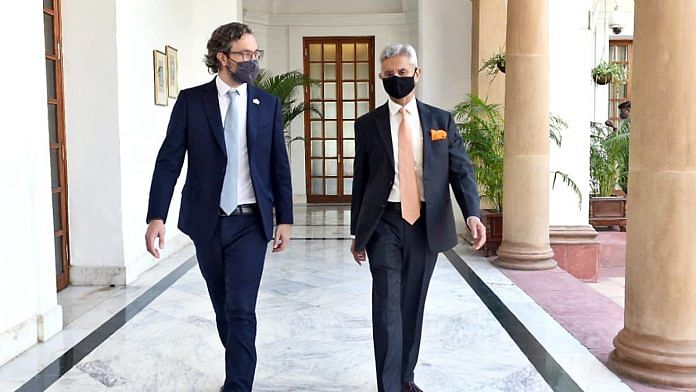New Delhi: Ahead of their talks on bilateral cooperation here Sunday, External Affairs Minister S Jaishankar, while welcoming Argentine Foreign Minister Santiago Cafiero, referenced a mid-20th century ‘Jute for Wheat’ agreement signed between New Delhi and Buenos Aires.
“Today, FM @SantiagoCafiero shared a family connection with India. His grandfather signed a ‘Jute for Wheat’ agreement with India in 1951,” tweeted Jaishankar.
Today, FM @SantiagoCafiero shared a family connection with India.
His grandfather signed a ‘Jute for Wheat’ agreement with India in 1951.
Counting on him to take this tradition further. https://t.co/Qt8DdTTgU6 pic.twitter.com/4PYBMgulN5
— Dr. S. Jaishankar (@DrSJaishankar) April 24, 2022
The trade agreement — first signed by the two countries in 1949 — was a unique barter treaty under which Argentina exported wheat to India in exchange for jute.
The agreement was inked around a time when parts of India were facing famine due to a series of natural disasters, and was looking to import grain. At the time, then American President Harry S. Truman had appealed to the US Congress to provide assistance to India so it could “meet the food crisis which now confronts the people of that country”.
Cafiero is on a visit to India to attend the three-day Raisina Dialogue — India’s flagship conference on geopolitics and geoeconomics committed to addressing the most challenging issues facing the global community — which began Monday. European Commission President Ursula von der Leyen also attended the event.
Asked why the ‘Jute for Wheat’ agreement is significant now, Arpita Mukherjee, a professor at the Indian Council for Research on International Economic Relations (ICRIER), a Delhi-based think tank, told ThePrint that “this is part of India’s preparations for the G20 presidency”.
“The reason why the external affairs minister is bringing this up now, especially after a visit from UK PM Boris Johnson and with European Commission President Ursula von der Leyen in town, may be for outreach to the G20 members,” she added.
India will hold the G20 presidency from 1 December, 2022, to 30 November, 2023, culminating with the G20 Summit in the country in 2023.
Also Read: ‘Look beyond Ukraine, world threw Afghanistan under the bus’: Jaishankar reminds Europe
Wheat for jute
In his 1990 book India’s Latin American Relations (1990), former Congress MP N. P. Chaudhary wrote: “Immediately after establishing diplomatic relations with Argentina in 1949, India entered into an agreement with it for supply of wheat in exchange for raw jute from India. That agreement was renewed next year.”
Due to the timing of the treaty — it was signed when India was a relatively new republic — there is little documentation of the agreement by the Indian government. However, it finds brief mention in archival material from the Ministry of External Affairs.
“Our ambassador presented his credentials on the 23rd June, 1949. The Argentine ambassador to India has been appointed and is likely to arrive in New Delhi shortly,” it states, and goes on to add: “An agreement has been entered into between the Governments of India and Argentine for the supply of wheat in exchange for raw jute from India.”
A foreign trade bulletin from the US Department of Commerce published in January 1950 also talks about a “commercial contract signed by India and the Argentine Republic on 30 December, 1949”, noting that the price of wheat was fixed at about £26 per metric ton and that of “jute manufactures” was approximately £204 per metric ton.
According to a 1951 document of the US Senate Committee on Finance, the barter agreement between India and Argentina was extended in December 1950.
A US Department of Agriculture memo dated 21 February, 1951, mentions a 1950 arrangement involving the “exchange of 50,000 tons of jute for 390,000 tons of wheat” between India and Argentina. It also mentions a “more recent” agreement calling for the exchange of “60,000 tons of Indian jute in exchange of 4,68,000 tonnes of Argentine wheat”. However, it does not specify whether the later agreement was a new one or an extension of the earlier deal.
India had opened a trade commission in Buenos Aires in 1943 and later converted it into one of its first embassies in South America in 1949.
Why did India need to sign the agreement?
According to a 1932 US government report titled ‘Textile Market of Argentina’, India was a leading commercial producer of jute around this period. It is still the largest producer of jute in the world.
At the time, due to a series of natural disasters including earthquakes, floods, drought and plagues of locusts, India’s grain crop in 1950 took a major hit, according to Truman’s message to Congress quoted earlier. It was therefore looking to import grain to feed its population in cities as well as rural areas.
The US was pondering sending food grain to New Delhi, which it eventually did through the India Emergency Food Assistance Act in June 1951.
Former US Senator Styles Bridges, as quoted in Congressional records dated 22 January, 1951, explained how New Delhi was reluctant to import grain from Pakistan at the time.
“In 1940, Pakistan is said to have offered to sell India 600,000 tons of wheat. Prime Minister Nehru spurned the offer at the same time that he was importing it at greater cost. The same situation still prevails. To be sure, the Pakistan exchange rate is something of an obstacle in that Pakistan did not devalue her currency when other nations in the Commonwealth followed the devaluation of the British pound…A similar situation prevails with respect to cotton: India has refused cotton from Pakistan while buying it from Egypt,” Bridges said.
(Edited by Gitanjali Das)
Also Read: Nehru’s 1949 ‘goodwill tour’ of US & how it opened a new chapter in bilateral relations



